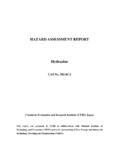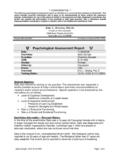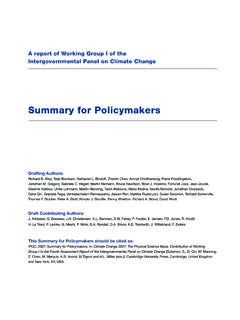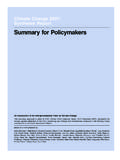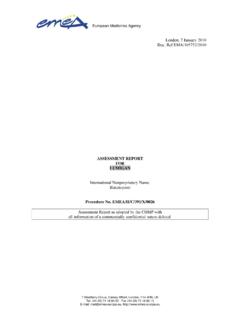Transcription of Safety Report Assessment Guide: LPG
1 PM/Technical/03 HID - Safety Report Assessment GUIDE: LPG Safety Report Assessment Guide: LPG Introduction The purpose of HSE s Assessment of a Safety Report against the criteria in the SRAM, is to come to a conclusion on whether the requirements and demonstrations in Schedule 4 Part 1 have been met. The extent of the information required for each demonstration to be made will depend on the level of proportionality considerations and the type of Safety Report required by COMAH Regs. 7 or 8. The different Report types include: the initial Report for existing establishments, pre-construction (PCSR), pre-operation (POSR), modification and updated reports. The predictive criteria are designed to help the Assessor make consistent professional judgements about whether the demonstrations in a Safety Report are adequate. Such demonstrations need to be based on a suitable and sufficient risk Assessment . The criteria are necessarily quite general, but sufficiently broad in nature to cover the various types of installation, the range of hazards to be encountered, and the types of risk Assessment that might be employed.
2 The purpose of this document is to describe how Assessors should test whether the criteria that applies to the predictive aspects of COMAH Safety reports have been met. It provides an interpretation of the criteria based on useful examples. The information supplements rather than supplants that in the Safety Report Assessment manual. The initial sections provide important background information, particularly on ALARP decisions and the application of the proportionality principle to the Assessment of Safety reports. Contents List 1 Introduction Fundamental Considerations Role of the Assessor Consistency and Proportionality Determination of Proportionality Deciding Whether the Risk is ALARP? How the Predictive Criteria Should be Used Assessment Against Criterion Assessment Against Criterion Assessment Against Criterion Assessment Against Criterion Assessment Against Criterion Assessment Against Criterion Assessment Against Criterion Assessment Against Criterion Assessment Against Criterion Assessment Against Criterion Assessment Against Criterion Assessment Against Criterion Assessment Against Criterion Assessment Against Criterion Assessment Against Criterion Assessment Against Criterion Assessment Against Criterion Assessment Against Criterion Assessment Against Criterion Assessment Against Criterion Assessment Against Criterion Assessment Against Criterion Assessment Against Criterion Assessment Against Criterion List of Tables Table 1 Off-site Accident Initiators Table 2 Accident Initiators Requiring Consideration in a Safety Report Table 3
3 Typical Failure Frequencies Table 4 Check List of Accident Initiators Table 5 Systematic Process for Criterion Table 6 Effect of Input Parameters on Predicted Accident Consequences Table 7 Typical Uncertainties in Consequence Modelling Criteria 1. Introduction The purpose of this document is to describe how the Competent Authority s Assessors test whether COMAH Safety reports meet the criteria that apply to the predictive aspects of COMAH. The information supplements rather than supplants that in the Safety Report Assessment manual. It is assumed that the Assessor is fully familiar with:- HSC/E s enforcement policy, the application of the ALARP principle and associated publications. COMAH Remodelling Policy and when this applies. The COMAH Training Manual. The contents of the HID Safety Report Assessment Manual (SRAM), particularly the guiding principles, and the procedures for handling and assessing Safety reports.
4 The sections below provide important background information, particularly on ALARP decisions and the application of the proportionality principle to the Assessment of Safety reports.. Fundamental Considerations Before assessing a Safety Report an Assessor needs to be clear about:- His/her role in the Assessment process and what the Safety Report Assessment Manager (AM) is expecting from the Assessment . The degree of proportionality that applies, this determines what can justifiably be expected from the Operator s risk Assessment (RA) - ie the depth of the arguments supporting the various demonstrations. HSE s approach to the application of the ALARP principle to on-site (ie HSW Act Section 2), and off-site (ie Section 3) risks for new and existing establishments. How the Assessment criteria should be applied and factors which influence the depth of the Assessment process; an important consideration is the type of Report being assessed eg first submission, or an update Report .
5 These issues are outlined in the remainder of this Introduction and are revisited as appropriate in later sections of the guidance. Role of the Assessor The predictive Assessment is pivotal to the demonstrations required under Section 4, Part 1, paragraph 2 of the COMAH Regulations; particularly the need to demonstrate that:- all major accident hazards (MAHs) have been identified; that all necessary measures to prevent and limit the consequences of these MAHs are identified and implemented. The Assessor s role relates solely to the risks to people both on-site and off-site. Risks to the environment are for the Environment Agencies and are not addressed here. When the Assessment of the predictive aspects of a Safety Report is complete, the Assessor should return the completed Assessment form to the Assessment Manager giving conclusions about whether:- the process of the hazard identification and risk analysis is fit for purpose; all MAHs have been identified; any gaps must be recorded on the AF; the consequence Assessment is adequate for the purposes of COMAH ie the extent and severity of representative MAs must be quantified (Schedule 4, Part 2, Paragraph 4).
6 The Assessment form allows Assessors to comment against each criterion and subcriterion. This guidance is designed to help provide consistent comments and conclusions and is structured in terms of questions which relate to the criteria and help to identify any weaknesses in the Safety Report . These should help Assessors to write succinct deficiency statements and make clear what is required eg further information or analysis or both. When filling in the Assessment form the paragraph number and page number in the Report should be shown for cross referencing purposes. For example:- Criterion Safety Report Refs Comments Issue* Category The Safety Report should identify all potential major accidents and define a representative and sufficient set for risk analysis pxx para yy The Safety Report does not identify catastrophic vessel failure leading to total loss of contents as a potential MA. The Report fails to meet criterion ; the Operator has to provide more information.
7 Decided by team at final meeting * The Issue Category relates to the inspection plan only. The assessor must also provide input to the Assessment team conclusions on whether the prevention and mitigation measures make risks ALARP. Consistency and Proportionality The Assessment approach needs to be proportionate and consistent, therefore Assessors should come to a view on proportionality before starting to assess a Report against the predictive criteria. Consistency does not mean uniformity. It means taking a similar approach in similar circumstances to achieve similar ends. For some, professional judgement may need to be exercised in order to come to a decision on whether the demonstrations in the Report are fit for purpose when assessed against the predictive criteria. The criteria and the associated guidance are designed to help Assessors exercise this judgement in a consistent way. Occasionally they may need to discuss some issues with HID colleagues who are familiar with the site, the land use planning situation, or the Operator s approach to discharging his Section 3 responsibilities, before reaching a decision.
8 The Assessment team have a key role to play in achieving consistency in the overall Assessment of Safety reports and in the drawing of the Competent Authorities (CAs) conclusions. Other ways of achieving consistency include; exemplar reports Lead unit system Sharing experiences through knowledge management systems. Proportionality is a fundamental consideration when exercising judgement on whether Assessment criteria are met or not. HSE `s view is that there must be some proportionality between the risk and the measures taken to control the risk. The phrase all measures necessary will be interpreted to include this principle . Proportionality is essentially determined by the severity of the worst possible consequences, ie those resulting from the worst case scenario, and the levels of risk (individual and societal), that remain after taking account of the prevention and mitigation measures the Operator has put in place.
9 The following factors are therefore important:- (a) the scale (inventory, vessel sizes, etc) and nature (hazardous properties, toxicity, flammability, etc) of the hazards; (b) the location of the site in relation to off-site populations; (c) the density and types of off-site population (eg dwellings, hospitals, schools, etc); (d) the number of people on site; (e) the variation of residual individual risks with Proportionality should influence the aspects on which Assessors focus the most attention ie the issues where the occupier is expected to provide convincing arguments to support the demonstrations. Information in the Safety Report should enable Assessors to fully understand site specific circumstances (on-site and off-site), so that a view on proportionality can be reached. The Report should therefore describe the processes, the hazardous substances involved and their effects on people, the distribution of people off-site, and the numbers of people on-site and their distribution in relation to the various installations.
10 To reach a view on proportionality the Assessor needs to know the potential maximum injury toll. Schedule 4, Part 2, Paragraph 4(b) requires the Operator to determine the extent and severity of the consequences of identified major accidents. Schedule 7 defines injury severity that constitutes a major accident. The threshold is a single death, six persons on the establishment hospitalised for at least 24 hours; or 1 person off-site hospitalised for at least 24 hrs. Severity therefore includes fatal and serious injury (ie hospitalisations) as a minimum. Operators must include the severity of the consequences for the worst case event in terms of expected numbers of fatalities and serious injuries in their accident consequence analysis. Less severe injuries should also be considered eg minor injuries. Proportionality and Depth of Risk Assessment Proportionality will influence the type and level of analysis detail that Assessors might expect to underpin the various demonstrations in the Safety Report .











